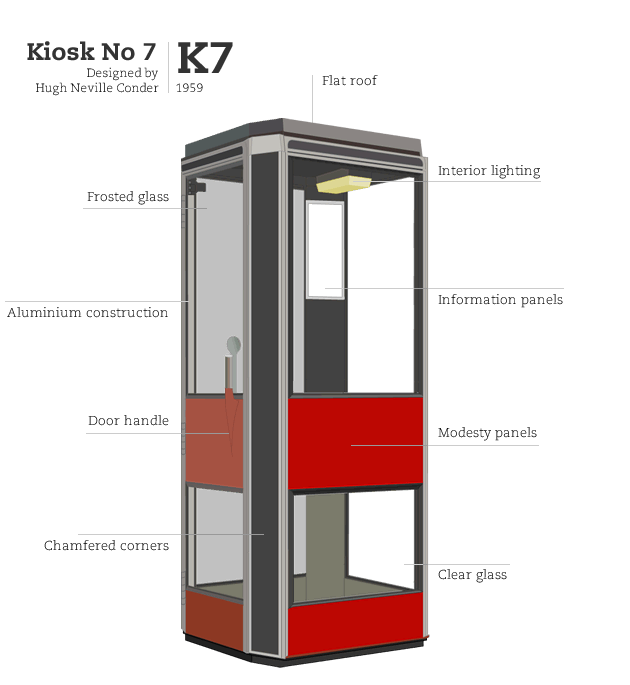The Story of Kiosk No 7
Summary
The K7 was a revolutionary design and equally radical in the use of materials, compared to earlier kiosks. The General Post Office wanted a modern kiosk to replace the K6 and considered designs by three of Britain's leading post war designers. Despite this flirtation with modernity the GPO was unconvinced by the K7. A small number of prototype K7s were installed, but it never went into final production, mirroring the fate of the K5 kiosk some three decades earlier.
Design
The K7 kiosk is constructed of aluminium (although the General Post Office produced six examples in cast-iron) standing on a narrow concrete base; the kiosk stands wider than the concrete base so that the kiosk 'floats' above the ground. Its general form is a four-sided rectangular box with a flat roof. The corners of the kiosk are chamfered, with narrow panels at a 45 degree angle to the main faces of the kiosk. These narrow panels are structural sections of aluminium with plastic cladding. All sides of kiosk are glazed, with modesty panels at waist height and a slim panel at the base of each side. These panels are red in colour. The glazing is held in place with rubber gaskets, in a similar way to modern car windscreens. One glazed side of the kiosk uses frosted glass, to improve the privacy of users. The door is identical in appearance to the other sides, with a 'column'-shaped handle on the outside and a 'pad' handle on the inside. Without a solid back panel (as with earlier kiosks) the telephone equipment is attached to the inside of one of the chamfered corners. Aside the telephone is a racking system for telephone directories. There is no external 'Telephone' signage, nor is there a Royal crown.
History
In 1959, as the country grew out of post-war austerity and set about creating a new modern Britain, the General Post Office looked again at its network of public payphones, dominated by the K6 kiosk of 1936. For all its charm and character today, at the time the K6 recalled a different era. Looking for a new national kiosk design, the General Post Office commissioned designs from Misha Black, Neville Conder and Jack Howe for a new kiosk. All proposed the use aluminium in its construction. Of the three designs, that by Neville Conder was chosen. There can be no starker comparison between the K6 and the K7. Conder was one of Britain's leading post-war architects designing modern buildings, often in concrete, and his innovative flair was clear in the design of the K7. However, neither the General Post Office nor the British weather liked aluminium. The climate caused discolouration and staining of the aluminium and the General Post Office, seemingly mistrustful of aluminium, secretly manufactured half a dozen cast-iron examples. With this lack of commitment to Conder's design, it is not surprising that the K7 never entered final production. Of the twelve prototype K7s some remained in service for some twenty years.
Heritage legacy
The K7 was produced in prototype form only. For the reasons discussed above, the K7 never made production. There are no known surviving examples of the K7 in public use remaining from the small number installed for evaluation. A surviving example resides as part of the National Telephone Kiosk Collection at the Avoncroft Museum of Historic Buildings, while a second is held in store by the UK Science Museum. The K7 is the rarest of all the surviving kiosk marques, in terms of numbers produced and numbers surviving.

